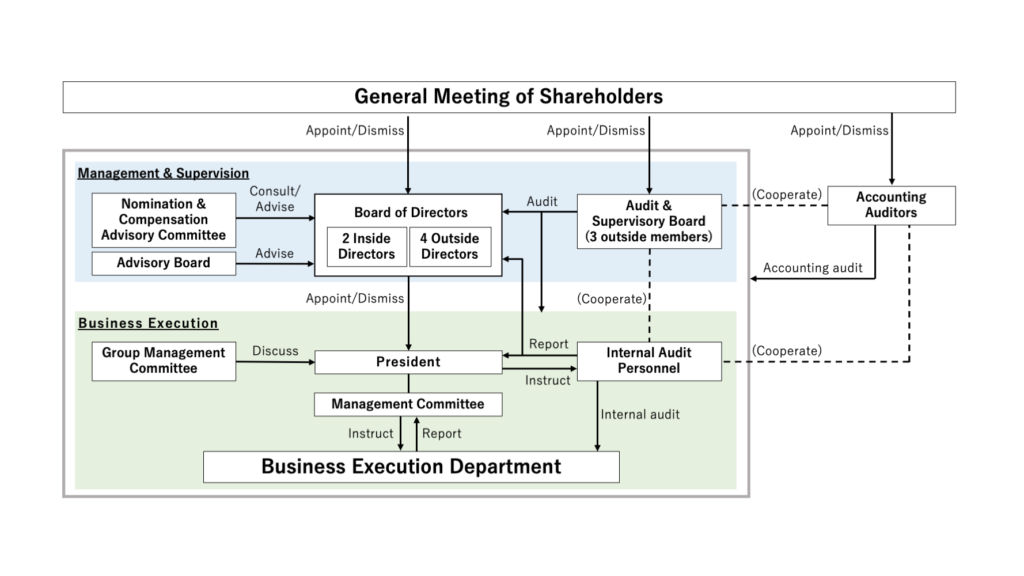Corporate Governance System
Overview of Corporate Governance System

The Status of Business Execution
1. Board of Directors
The Board of Directors, which is responsible for making decisions on important management issues, holds regular meetings once a month and extraordinary meetings as necessary.
Our policy is to have at least two outside directors in principle to strengthen corporate governance. (The current Board of Directors is composed of four male directors and two female directors.)
2. Management Committee
The Management Committee comprises full-time directors, a full-time Audit & Supervisory Board member, executive officers, Chief Transformation Officer (CXO), Chief Strategy Officer (CSO), division and department chiefs. If required, other managers are summoned to meetings and asked to make a detailed report. The Management Committee, which serves as a decision-making body for day-to-day business operations, meets once a month. Executive officers are delegated responsibility for business execution with the approval of the Board of Directors in accordance with regulations in order to facilitate decision-making and execution. They are obliged to participate in management meetings, report on business execution, and promptly implement resolutions. (All of the Management Committee members are male)
3. Group Management Committee
The Group Management Committee, as a deliberative body for important matters concerning general management and business operations, consists of members appointed by full-time directors and the president. While a full-time Audit & Supervisory Board member attends as an observer, outside directors and part-time Audit & Supervisory Board members participate as observers on a voluntary basis. When deemed necessary, the Group Management Committee may invite those in charge of the matter in question to attend meetings and hear their opinions. In principle, the meeting is held once a month.
4. Nomination & Compensation Advisory Committee
The Nomination & Compensation Advisory Committee is a voluntary advisory body to the Board of Directors, chaired by an outside director. The majority of the committee members are independent outside directors and independent outside Audit & Supervisory Board members, thereby strengthening the supervision of the Board of Directors and increasing transparency in the decision-making process.
In addition to the predetermined annual meeting schedule, the committee meets as needed.
5. Advisory Board
The Advisory Board, as an advisory body to the Board of Directors, is composed of the members of the Board of Directors and experts appointed by the president and meets three times a year in principle. Their role is to offer management advice using their long experience and outstanding knowledge in various areas, improve the soundness and transparency of group management, and strengthen corporate governance.
6. Risk Management Committee
In addition to the regular monthly meetings of the Board of Directors, we hold meetings once a month of the Management Committee and the Risk Management Committee, both of which consist of full-time board members and executive officers. Members in these meetings share information that could have a significant impact on business execution and discuss potential responses to them.
They also deliberate on whether or not to implement any action that is legally questionable after consulting with external experts.
The Status of Audit and Oversight
1. Audit & Supervisory Board
Asteria adopts the Audit & Supervisory Board system. The board oversees the execution of duties by the Board of Directors and holds regular meetings once a month plus extraordinary meetings as necessary. The Audit & Supervisory Board members attend meetings of the Board of Directors and supervise overall management. A full-time Audit & Supervisory Board member attends management meetings and conducts audits of overall management. In addition, during the visits and reviews by accounting auditors, the member is informed of the company’s accounting status and can exchange opinions and information with them. (The Audit & Supervisory Board is composed of two male members and one female member.)
2. Internal Audit
Regarding the assessment of the effectiveness of internal control and business execution status, those in charge of internal audits who report directly to the president continuously conduct necessary internal oversight in cooperation with each department. The internal audit personnel also exchange opinions with the Audit & Supervisory Board members and accounting auditors to enhance internal control. The results of internal audits are reported directly to the president, the Board of Directors, the Audit & Supervisory Board and its members. Matters requiring improvement are notified to the departments subject to audit and check the progress of improvement.
Nomination and the Determination of Compensation
The selection of candidates for directors and the Audit & Supervisory Board members and their compensation are discussed with the Nomination & Compensation Advisory Committee, and decisions are made by the Board of Directors based on the committee’s report.
Upcoming Events
| – | – |
|---|








